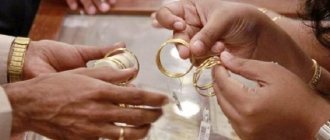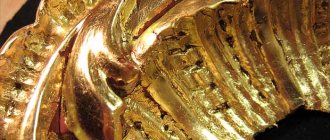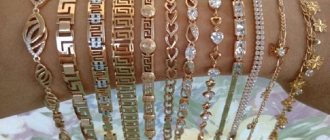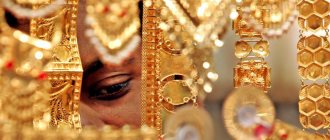Ancient Egypt and its “golden” history
For the world history of gold, Egypt and the gold of Ancient Egypt ranks first among other states of ancient times.
Egypt organized an industry for the extraction of this precious metal and had everything necessary for its search and extraction. With great confidence, scientists say that it was Ancient Egypt that became the first in gold mining. For the ancient Egyptians, gold was not just a precious metal, they compared it with the brilliance of the Sun, which was considered a deity. For a long time, the most revered god for them was the heavenly body, whose name is RA. The ancient inhabitants of this country firmly believed that, like all gods, his skin was made of this precious metal. There is an ancient belief that a precious rainfall passed over the earth, and the moisture, absorbed into the soil, left precious ingots in it.
Gold mining in Ancient Egypt
The history of gold in Ancient Egypt began several thousand years ago before the beginning of modern time. Historians are confident that its mining began in the mountainous area between the Red Sea and the Nile River, which is approximately 1,000 kilometers long. And by today's standards, this area is considered quite extensive for the extraction of the precious metal - gold. Residents divided it into three parts:
- the part of Nubia, located in the northern territory, was called Uauat, which was considered the richest in terms of mining this revered and precious metal;
- Koptos;
- Kush.
The location of these gold deposits is not known to this day. They are called Hammamat, their name comes from the name of the mountain that stands on the seashore. They existed more than 2,500 BC. Several ancient Egyptian documents indicate gold mining in the Elefontine deposits. Experts found that some places with precious metal deposits were under development and were located in Nubia itself.
Judging by ancient records and pictures on stones, we can come to the conclusion that in this ancient country there were such old mines where gold mining was carried out for several thousand years. During its history, Egypt was able to create the largest “gold industry” for that time in ancient times. All metal mining sites were the property of only the ruler, which means that all the gold mined in ancient Egypt belonged to them. Thousands of slaves were engaged in the extraction itself.
America's Gold
After Columbus discovered America in the 16th century, the situation changed dramatically. It is estimated that the looting of the treasures of the South American Indians in 1530 brought about 8 tons of gold. After establishing colonies and opening mines in Mexico and South America, Spain was receiving more than 4 tons of gold per year in the 1550s.
According to various estimates, during the 16th century Spain received from its American colonies between 154 and 311 tons of gold, which is approximately 40% of the gold mined worldwide during this period.
Gold of the Pharaohs of Ancient Egypt
In ancient times, without a doubt, Egypt was considered the richest state. Around 3500 BC there was no silver in Egypt, and its value at that time was higher than gold. This changed only with the advent of trade with eastern countries, where silver was in sufficient quantities.
At that time, the rulers of Ancient Egypt (the pharaohs) were able to manage their enormous wealth with a certain prudence. Many items that were intended for burial were not actually made of pure gold, but were simply gilded. Jewelers of Ancient Egypt could make gold foil, it was almost as thin as in the modern world.
Research shows that at that time in Africa the amount of gold mining was equal to 4000 tons, and almost all of it was mined by numerous Egyptian slaves, only about 320 tons were mined during the reign of Rome.
Other ancient states were never able to achieve this level of prosperity, like Egypt in ancient times. It has existed for more than 3,500 years and during its existence it has made a huge contribution not only to the general history of the world, but also to the history of world gold mining.
LiveInternetLiveInternet
flower delivery Ekaterinburg Bracelet of Queen Ahhotep Around 1530 BC.
e. Gold, lapis lazuli, carnelian, turquoise Length 15 cm; width 4.3 cm Egyptian Museum Cairo The name of the queen is engraved on the clasp Treasures of the wives of Thutmose III Around 1504 - 1450 BC e. Gold, carnelian, glass Metropolitan Museum of New York Sandals and bracelets come from the burial of the three wives of King Thutmose III - Menkhet, Merti and Menwai Bracelet Late 1st century BC. e. Gold, glass 4.5 x 9 x 4.5 cm From Meroe (Northern Necropolis). State Collection of Egyptian Art. Munich Bracelets and earrings 15 - 14 centuries BC. e. Gold Diameter 10.5, 5.8 and 10.5 cm State Museum of Antiquities Leiden Although earrings have been known since the 5th dynasty, they only came into fashion in the 18th. They were worn by both men and women of the Golden Throne of Tutankhamun. Side view Late 18th Dynasty (c. 1333 - 1323 BC) Wood, gold leaf, colored glass, enamel, semi-precious stones; inlay National Museum Cairo Bracelets from the tomb of King Djer Beginning of the 3rd millennium BC e. (1st dynasty) Gold, semi-precious stones, faience Length 10.2 - 15.6 cm Egyptian Museum Pectoral of Princess Mereret Around 1840 BC. e. Gold, carnelian, lapis lazuli, faience 7.9 x 10.5 cm Egyptian Museum Cairo Belt Circa 1840 BC e. Gold, amethyst Length 60 cm Egyptian Museum Cairo The belt belonged to Princess Mereret, daughter of Senusret III. It consists of amethyst beads and golden panther heads, connected in pairs. The panther was the embodiment of the divine principle and the protector of people. Diadem of the princess Sat-Hathor-Iunit Around 1800 BC. e. (reign of Amenemhet III) Gold, lapis lazuli, carnelian, green faience Height about 44 cm; width 19.2 cm Egyptian Museum Cairo The owner of this masterpiece of jewelry was one of the daughters of Senusret II Bracelet of Queen Ahhotep Around 1530 BC. e. Gold, lapis lazuli, carnelian, turquoise, glass Diameter 6.1 - 7.3 cm, height 7.3 cm Egyptian Museum Cairo Heart scarab of the military leader Jhuti (abdomen) Around 1450 BC. e. Slate, gold National Museum of Antiquities Leiden Warlord Jhuti's Heart Scarab (back) Around 1450 BC. e. Slate, gold 8, 3 x 5, 3 x 2, 7 (scarab); chain length 133 cm National Museum of Antiquities Leiden Large necklace in the shape of a cobra. Fragment 14th century BC. e. Gold; coinage National Museum Cairo Found in the tomb of Pharaoh Tutankhamun Mirror frame “Ankh” or “Cross of Life” 14th century BC e. Wood, gold, colored glass paste; inlay Height 27 cm National Museum Cairo Found in the tomb of Pharaoh Tutankhamun Incense box 14th century BC e. National Museum Cairo Found in the tomb of Tutankhamun. Made in the form of a double scroll, inlaid with colored glass paste Necklace Around 1400 BC. e. Faience Length 38 cm Egyptian Museum Berlin The main motif of this beautiful necklace is the buds and flowers of a pomegranate Beads Around 1375 BC e. Gold, carnelian, turquoise, glass Length (from top to bottom): 28.5.51 and 34.5 cm State Museum of Antiquities Leiden Pectoral depicting the sacred scarab beetle surrounded by royal uraeus and floral designs Around 1350 BC. e. Gold, lapis lazuli, turquoise, carnelian, glass National Museum Cairo Pectoral with scarabs and floral designs Around 1350 BC. e. Gold, lapis lazuli, carnelian, glass National Museum Cairo The symbols of the Moon (god Thoth) and the Sun (god Ra) are depicted here. Bracelet with an amulet "udjat" Around 1334 - 1328 BC. e. Gold, carnelian, glass Length 16.2 cm; width 2.7 cm Egyptian Museum Cairo Bracelet with scarab Around 1334 - 1328 BC. e. Gold, lapis lazuli, quartz, turquoise, carnelian Max. diameter 5.4 cm Egyptian Museum Cairo The scarab (“kheper”) was considered a symbol of the morning sun, with which the deceased king was identified. The very color of blue lapis lazuli meant eternal life. Detail of a necklace (pectoral) Around 1334 - 1328 BC. e. Egyptian Museum Cairo Necklace with pectoral in the form of the goddess Nekhbet Circa 1334 - 1328 BC. e. Gold, lapis lazuli, carnelian, obsidian, glass Pectoral height 6.5 cm; pectoral width 11 cm Egyptian Museum Cairo Necklace with a pectoral in the form of the goddess Nekhbet (reverse side of the pectoral) Around 1334 - 1328 BC. e. Egyptian Museum Cairo On the chest of the goddess Nekhbet is a necklace with a cartouche of Tutankhamun. Pectoral in the form of a falcon Around 1334 - 1328 BC. e. Gold, lapis lazuli, carnelian, turquoise, obsidian, glass Width 12.6 cm Egyptian Museum Cairo Rings Around 1334 - 1328 BC e. Gold Egyptian Museum Cairo The rings depict one of the most important deities of the Egyptian pantheon, whose cult was restored by Tutankhamun after 17 years of oblivion under the “heretic” pharaoh Akhenaten. This is Ra-Horakhty, which means “Ra-Hor of the horizon.” Funeral mask of the Egyptian pharaoh Tutankhamun, 14th century BC. e. Gold Egyptian National Museum Cairo Bracelets of Ramses II Around 1290 BC e. Gold, lapis lazuli Width 6 cm; maximum diameter 7.2 cm Egyptian Museum Cairo These excellent bracelets were accidentally discovered during the construction of the railway near Tel Basta (ancient Bubastis), in the cache of a temple that was once located here. Vessels made of gold and silver were also kept there. Bracelet with a clasp in the form of a scarab beetle Gold, carnelian turquoise, feldspar, lapis lazuli National Museum Cairo Stacked bracelet with a clasp in the form of a scarab. Fragment Gold, amethyst, semi-precious stones National Museum Cairo The stacked bracelet alternates rows of scarabs and Wadjet eyes, separated by gold balls. The clasp is made in the form of an amethyst scarab in a gold frame with images of uraei. Pectoral with sister goddesses Nephthys and Isis. Fragment of Zolloto, lapis lazuli, carnelian, glass National Museum Cairo Sister goddesses Nephthys and Isis, crouched on the sides of a large scarab. The solar disk, scarab and uraei form the formula for the resurrection of the pharaoh coming to life in the afterlife. Necklace with endings in the form of a falcon's head. Fragment Necklace with the image of the divine bird - falcon Necklace with images of a vulture and a cobra Pectoral with the sister goddesses Nephthys and Isis. Fragment of a Pectoral with the image of a sacred scarab beetle surrounded by royal urei Gold, lapis lazuli, turquoise, carnelian. National Museum Cairo This decoration was suspended on long strings of beads with inlaid clasps, the shape of which often repeated the decorative elements of the pectoral itself. Decoration Gold, carnelian, turquoise, colored paste; inlay National Museum Cairo To the left of the eye is Horus - the patroness of Upper Egypt, the goddess Nekhbet (Vulture), to the right - the patroness of Lower Egypt, the goddess Wajit (Cobra) Earrings with Egyptian crowns 3 - 2 centuries BC. e. Gold, semi-precious stones, glass Length 7.2 cm Christos G. Bastis Collection New York Medallion depicting Isis and Serapis 222 - 180 BC. e. (reign of Ptolemy IV or Ptolemy V) Gold 2.8 x 2.4 cm Brooklyn Museum New York Ring with the image of the god Sebiumeker Late 1st century BC. e. Gold, glass Ring diameter 1.8 cm; shield: 4.7 x 3.6 cm From Meroe (Northern Necropolis). Now - Munich State Collection of Egyptian Art The Meroitic deity Sebiumeker is depicted with a beard, wearing a double Egyptian crown. A wide necklace and a temple facade are a typical decorative motif of Meroitic art. The identification of the ram-headed deity remains in doubt. Ring Around 70 AD. e. Gold Length 4.8 cm Center for the Study of Greco-Roman Egypt Trier The ring is made in the shape of a coiled snake with busts of Isis and Serapis at the ends of the tail. Similar decorations are not uncommon in Fayum portraits. Beads with a “lunula” pendant, 2nd century AD. e. Gold, amethyst, pearls Length 41 cm Antique collection Berlin Crescent-shaped “lunula” pendant was common as an amulet on female portraits of mummies from the second half of the 2nd century Capsule-amulet 2nd century AD. e. Gold Length 3.5 cm, diameter 1.2 cm Museum of Late Antique and Byzantine Art Berlin Earring 2 - 3 century AD. e. Gold Height 3.5 cm Antique collection Berlin On a wide ring hangs a pyramid, top down, ending with three balls. This type of decoration is known only in Egypt https://blogs.privet.ru/user/olyalya_573?year=2010&month=8











